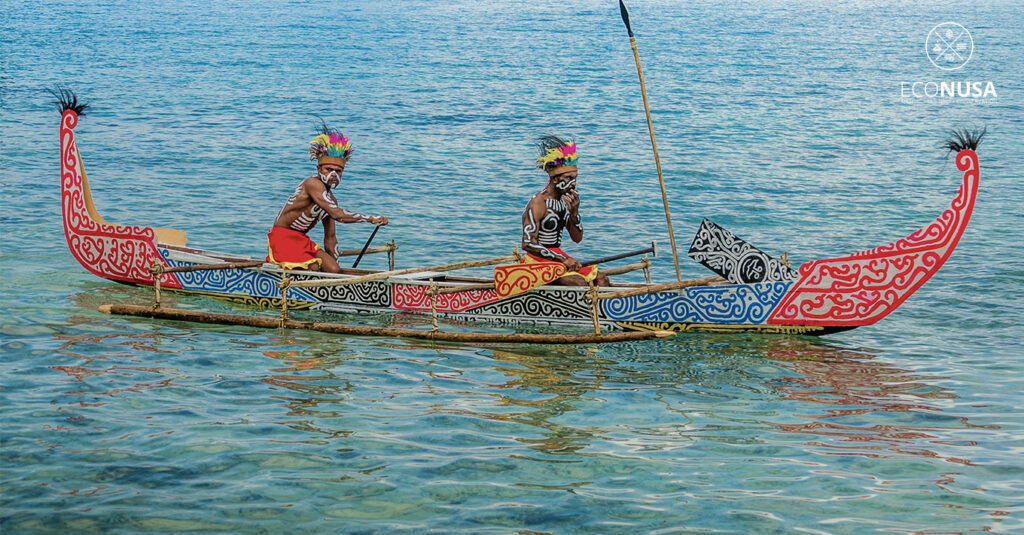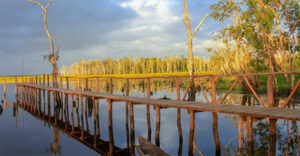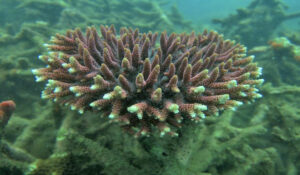
Biak Tribe is known as the notable sea traveler. The tribe from Biak and Numfor Islands here could create various kinds of boat based on need which then becomes their tradition. The motif varies from a need for livelihood up through to slave hunt.
In a journal entitled “Biak Numfor People Before 19th Century: A Maritime Historical Review” by Usmany (2014) the Biak-Numfor people consider boat as the priceless thing. The boat shape is based on the needs. It makes Biak Tribe known with the various type of traditional boats such as wairon and mansusu.
Read also: Retracting Egek, Looking at Moi Tribe’s Natural Deposit
Wairon is the name for a slim boat for warfare. At the time in the 19th century, war was common to show social status. The wairon boat did not use any sail cloth to ease the mobilization on the battle. In addition to warfare, the boat hear was also used for commercial purpose in which the sail cloth was put on to ease the speed.
Meanwhile, mansusu is a kind of boat used for cargo of food and matrimonial property. With the cargo function, the boat has larger size and could accommodate up to 40 passengers. The typical characteristic of the boat is the similar shape of the front and rear parts to ease the mobilization in case of hostility.
During the sea trip, the wairon was usually on the leading position, the left, right, and back side of mansusu. However, on a certain situation, wairon was only at the front and both sides leaving mansusu on the back. It was intended to anticipate the high wave and avoid other group attack.
Read also: Om, Priceless Food for Ngalum Ok Tribe
The sailing motif of Biak Tribe is related to the relationship with Tidore Kingdom. Before 19th century, or prior to Tidore conquest, Biak people went on sea to meet their livelihood. The sail was done during dry season and their dwelling was in drought.
There are two kinds of cruises for food, fadaduren and wadwai. Fadaduren is the cruise in search of food with barter system. Wadwai is the cruise for food by fishing and gardening in a more faraway spot.
Besides, the Biak Tribe also went on sea for an exploration which is locally called bawores. The cruise was usually driven by the need to meet the matrimonial property and competition for prestige, which is called ego korfandi, The bawores motive here led them to Raja Ampat in West Papua.
Read also: Forest as a Source of Medicine for Dani Tribe
After the conquest of Tidor at the western coast and Papua bird head, the sail motif of Biak people was driven more by seeking slave. The Tidore Sultan appointed tribal chiefs as the rulers provided that they gave compensation to the sultan. One of the levies wanted by Tidore Kingdom at the time was slave.
Biak Tribe then hunted for slave to meet the levy for Tidore Kingdom. At the time, slave was one of the major trading commodities. Not only as the levy to sultan, but they also traded the captured slaves. The mansusu boat which was formerly used as food cargo then transformed as the captured slaves transporter.
In the navigation context, Biak Tribe used stars as the guidance. For instance, to determine the wind direction, Biak Tribe used morning star (kumeser wanurem) on the dawn as the sign of East direction. And the afternoon star (makmandira) during sunset was signified as the South direction.
Read also: Boosting Nutmeg Productivity in Kaimana
Some stars were also used as the reference to define the season such as an Orion (Sawakoi) and Scorpio (Romanggauandi) stars. From the star constellation, they could divide season into two big categories, namely wampasi and wambraw. Wampasi is for the situation when sea is calm, and wambraw is for signify a wavy sea.
To trace back the ancestor’s cruise track, in 2018 a capitaru (boat captain), Denis Koibur, jointly with Manawir (tribal chief) Apolos Sroyer and some other crews traveled by boat with wairon boat from Biak to take part in Boat and War Festival in Papua New Guinea. They departed from Biak on 25 September 2018 and dropped a visit at Nusi and Yapen Islands.
After eight-day cruise, on 2 October 2018, the wairon trip anchored at Dok II Jayapura beach. Their arrival was hailed by traditional dance from Tanah Tabi and Klemen Tinai, the Papua Deputy Governor at the time. In Jayapura they asked permit to sail to Papua New Guinea.
Read also: Paniai Coffee at a Glance
The wairon boat was then arrived at Milne Bay Province in Papua New Guinea on 3 December 2018. As to Denis Koibur, as reported by papua.go.id, the travel here was the first after 100 years. “One thing for sure is that it was the first travel after 100 years. We have so far only sailed around the existing islands in Biak,” said Denis.
Editor: Nur Alfiyah & Lutfy Putra




